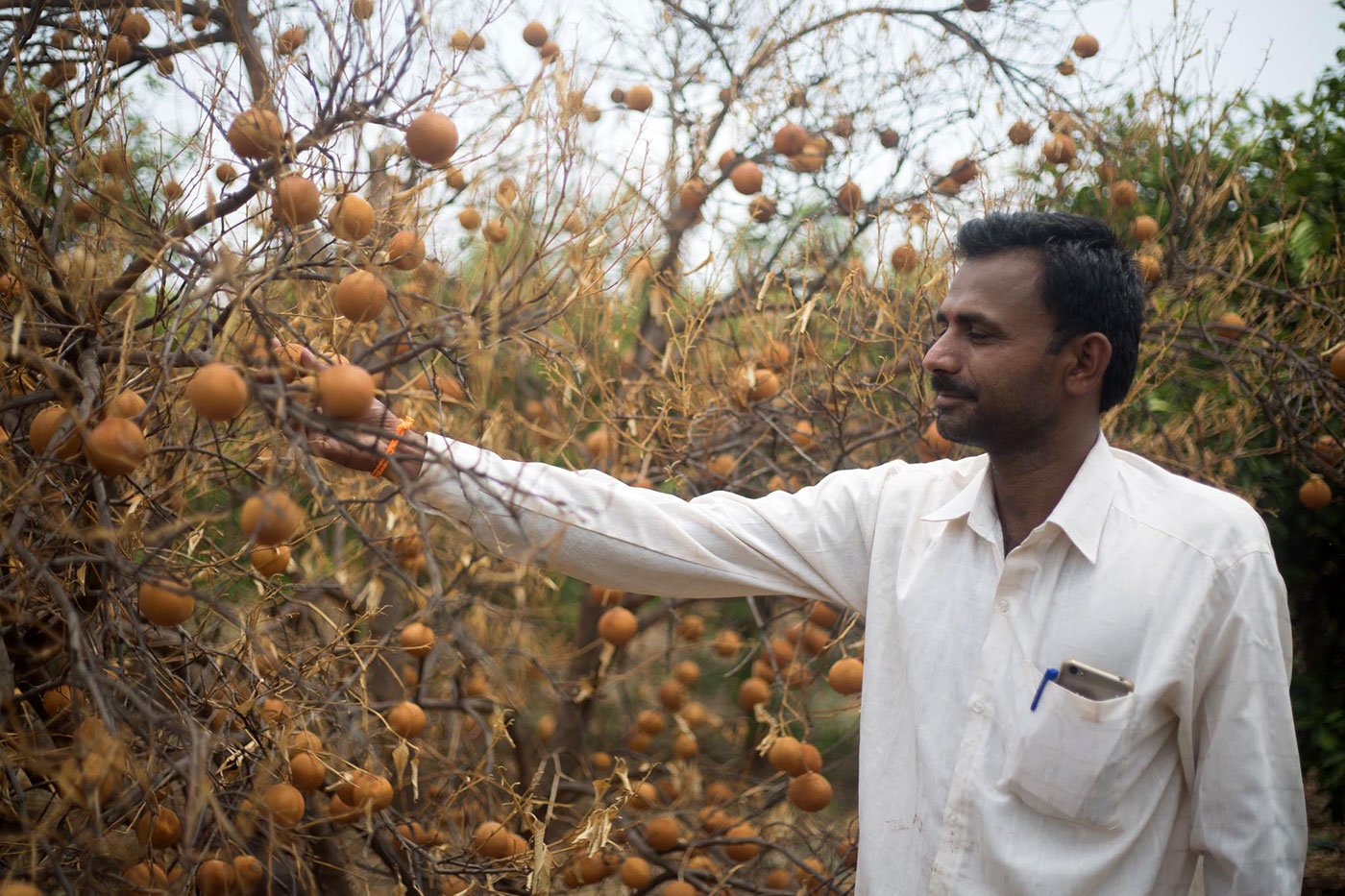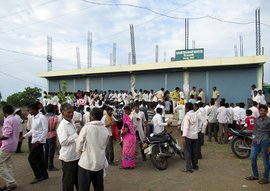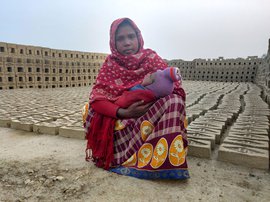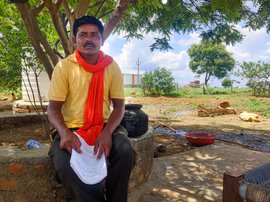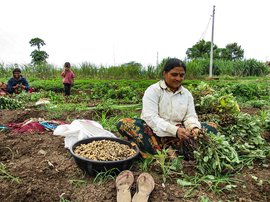Shivaji Thomre has 13 acres of farmland. Meandering across his ploughed fields being readied for cotton, jowar and corn, we come upon a patch of dried trees under which round yellow fruits – akin to sucked-up lemons – lie scattered. “This is mosambi (sweet lime),” says Shivaji, picking one up. “It needs 60 litres of water per plant per day in ideal conditions. The mosambi have totally dried up.”
Thomre has 400 mosambi trees on two acres – that means 24,000 litres of water per day in summer, good rains in the monsoon, and nearly as many litres in the winter. Other fruit trees require much less –pomegranate, for example, requires around 20 liters per day per tree in summer.
Thomre's father had planted the trees in 2002 in Karajgaon, their village of around 1300 people on the outskirts of Aurangabad city in Marathwada. Shivaji was only 20 at the time. “Water was not an issue back then,” he recalls. Rainfall was relatively reliable, and he family’s private well had enough water. “Planting mosambi was a wise and lucrative option.”
Mosambi orchards are spread across every village in the 60-kilometre belt that begins from the Aurangabad highway and leads to Jalna. All of them were planted in the early-2000s, and all of the orchard owners are struggling today.
The fruit is not easy to cultivate. The trees must be nurtured for four to five years before they bear mosambi , but after that, a bi-annual yield is assured for 25-30 years. Shivaji’s orchard, however, bore fruit for only four years, from 2006 to 2010.
In a good year, Shivaji says he would get around 15-20 tonnes of mosambi . “At an average of Rs. 30,000 per tonne [sale price] I lost around Rs. 3.5 to 4 lakhs this season,” he says, sitting under a barren mosambi tree. “That is not counting the one lakh I invested in the orchard through the year. The last five years have been devastating for this fruit.”
The prolonged rough phase has compelled Shivaji’s wife Jyoti to work as an agriculture labourer on other farms. “I work at a daily wage of 150 rupees,” she says. “It adds to the family’s income. You never know when you will need extra money. Our seven-year-old niece has been hospitalised in Aurangabad for the past two days. She has to be operated for a cyst. We have already spent Rs. 15,000.”
Living in a joint family of 18, Shivaji would not have been able to pull through on agriculture alone. The family runs an electronics shop in the village, and Shivaji himself works as a business correspondent in Bank of Maharashtra’s Karmad branch, earning Rs. 7,000 a month. “We have a loan of Rs. 8 lakhs [from the bank, accumulated over five years],” he says. “We have to think of alternatives to mosambi .”
And so Shivaji plans to phase out the orchard. The trees his father planted 15 years ago will be uprooted. The process has already begun. “Of our 400 trees, 50 were removed this season [in the summer of 2017],” he says. “I hired a JCB machine. I will gradually get rid of all of them. There is no point in sticking to a financially uncertain and water-intensive crop.”
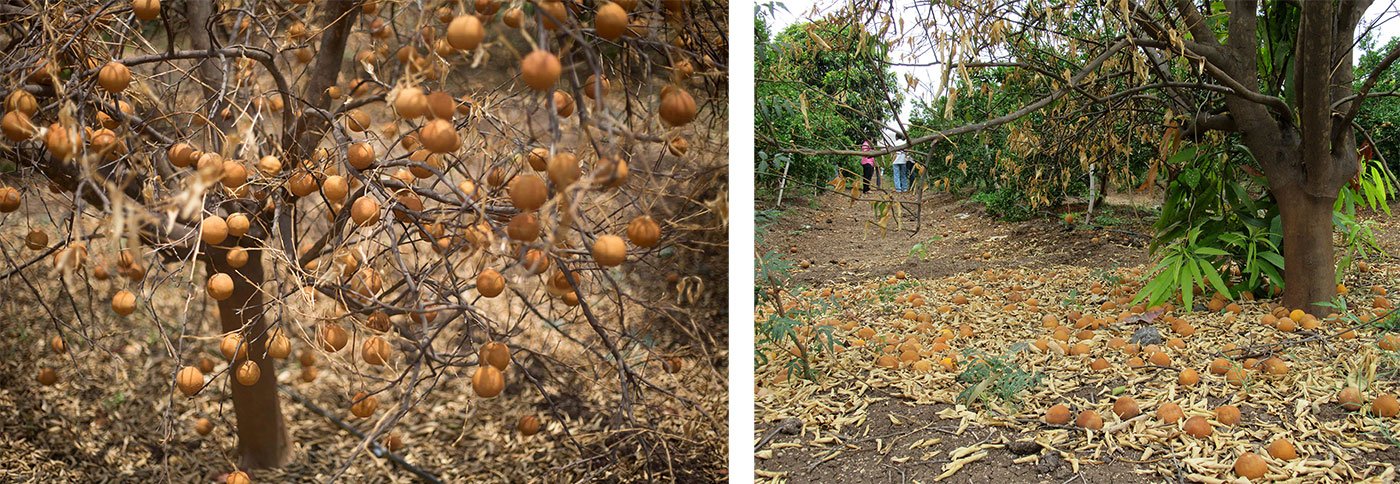
Aurangabad, Jalna and Nanded districts are among the foremost suppliers of
mosambi
to the rest of the country
Scorching heat is also harmful for
mosambi
. The 2017 heat wave in Marathwada – when temperatures were consistently 45 degree Celsius at the end of April and in May – has seared the fruit. “It has resulted in premature fruit drops,” says Shivaji. “The extensive heat weakens the tissue.”
Aurangabad, Jalna and Nanded districts in Marathwada are major cultivators of
mosambi
and among the foremost suppliers of the fruit to the rest of the country. Now, however,
mosambi
in Marathwada may be on the path to extinction. Several farmers are opting instead to grow other fruit like pomegranate, which demand less water; and some are returning to traditional
kharif
crops like
tur
and cotton.
As much as 30 per cent of the plantations were uprooted in 2013 alone, when over 1.5 lakh acres of mosambi plantation across Marathwada had been affected, with many farmers reportedly keeping their plants alive with sewage water. The better-off farmers spent a fortune on water tankers.
Bhere, too, has had the orchard since 2000. The last five years, he says, have been nightmarish. “I have run up a debt of Rs.4 lakhs,” he says. “My daughter got married three months ago. The situation gets grim when you need money for a wedding and are banking on mosambi . I have now sunk a farm pond and am hoping it will help.”

Bhausaheb Bhere: 'The situation gets grim when you need money for a wedding and are banking on
mosambi
'
The state government is offering subsidies to farmers to across Maharashtra to build farm ponds for water conservation. The water intensive nature of the
mosambi
plant has compelled many farmers to opt for the subsidy. However, according to statistics obtained from the divisional commissioner’s office in Aurangabad, only 13,613 farm ponds were completed in the eight districts of Marathwada in 2016-17, against the administration's plan to build 39,600 ponds. And of the 13,613 farmers who have built ponds, 4,429 have not yet received their subsidy.
Nonetheless, a farm pond is Bhere’s last throw of the dice, and he has spent Rs.2 lakhs on it. He hopes a decent monsoon will fill up the pond, making it easier for him to maintain the mosambi orchard. “This is it,” he says. “If the experiment fails, the orchard will not see 2018.”
Photos: Shrirang Swarge
